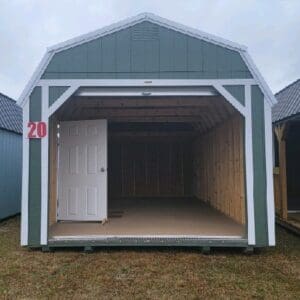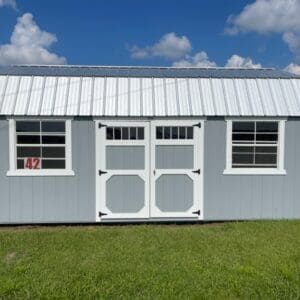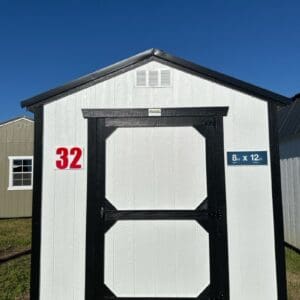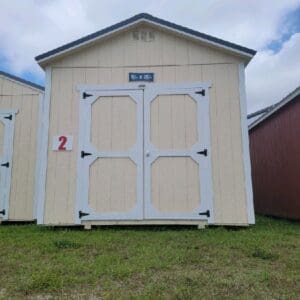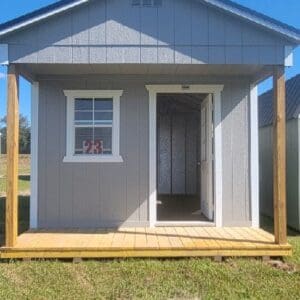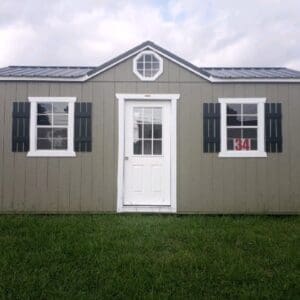
Storage sheds are incredibly utilitarian structures. They’re versatile and customizable, making it easy to enhance your yard’s aesthetic appeal. No matter what its intended purpose, a storage shed is always a practical and stylish option for homeowners. This complete guide to storage sheds explores the key things to know, from selecting the right type to creative uses beyond mere storage.
Types of Storage Sheds
There’s more than one type of storage shed to choose from. Each has its own benefits and drawbacks. Discover your material options below.
Wooden Sheds
Wooden sheds are a classic choice for many homeowners. These sheds are sturdy and offer a timeless aesthetic that can easily blend into any landscape. You can also customize them with paint or stains, and they often come with built-in shelving and windows for added functionality. However, they do require more maintenance than other types, such as regular painting and sealing, to prevent rot and insect damage.
Metal Sheds
Metal sheds are known for their robustness and long-lasting durability. These sheds usually consist of galvanized steel or aluminum and offer protection from pests, fire, and decay. They can also come with reinforced doors and locking mechanisms, making them more secure. While they don’t have the same appeal as wooden sheds, many modern designs include attractive finishes and features. One downside is that they can get quite hot during the summer months, so proper ventilation is crucial.
Plastic Sheds
Plastic sheds are an excellent option if low maintenance is a priority. Manufacturers construct these sheds from high-density polyethylene or resin, making them weather- and corrosion-resistant. They are also lightweight and easy to assemble and move. While plastic sheds might not have the same structural integrity as their wooden or metal counterparts, advancements in their design have significantly improved their durability and appearance.
Factors To Consider Before Buying a Storage Shed
Once you’ve selected your desired material, you must consider a few basic factors to ensure you get the shed that meets your requirements.
Size and Space
One of the first factors to consider when purchasing a storage shed is its size and available yard space. Start by assessing what you plan to store. Measure your yard and choose a location that provides easy access while leaving enough space for other outdoor activities. Additionally, consider the shed’s height. Taller walls and ceilings can offer more vertical storage options, allowing you to make better use of the internal space. Ensure that the shed’s footprint aligns with your needs and complements your outdoor layout.
Weather and Climate
Weather and climate are additional factors to consider when choosing a storage shed. Your shed’s design and construction should be suitable for the environment in which you live. Insulation and ventilation are vital for comfort in regions prone to extreme temperatures, whether hot or cold. Your shed’s structural integrity can impact its safety and longevity if your area experiences heavy snowfall. Wind resistance is another consideration, particularly in regions that experience strong winds or hurricanes. Secure anchoring and sturdy construction materials are necessary to prevent high wind speeds from damaging or blowing your shed away.
Cost of Installation
The cost of installing a storage shed can vary significantly depending on several factors, including the type of shed, the materials used, and the complexity of the installation process. Be sure to plan for potential expenses, such as site preparation, foundation laying, and any necessary permits when planning your project. Set a budget before you start shopping and stick to it to ensure you don’t overspend. Remember that while cheaper options may save you money upfront, investing in a higher-quality shed could save you maintenance costs in the long run.
Local Regulations and Zoning
Familiarizing yourself with local regulations and zoning laws is important before purchasing or installing a storage shed. Municipalities often have specific requirements regarding the placement, size, and design of outdoor structures. These regulations may dictate the minimum distance a shed must be from property lines, height restrictions, and whether your shed will require a building permit. You must also check whether your neighborhood has homeowner association (HOA) rules that might affect your plans. Some areas may have aesthetic guidelines or restrictions on the types of materials you can use. Failing to comply with these regulations can lead to fines, mandated removal of the shed, or other legal complications.
Planning and Preparing for a Storage Shed
Proper site preparation is crucial for your shed’s longevity and stability. Choose a level area with good drainage to prevent water accumulation. Then, clear away excess dirt, debris, and vegetation. Depending on your shed’s foundation requirements, you may need to install a concrete slab, gravel base, or wooden platform. While some sheds come fully assembled, others require a DIY approach. Follow the manufacturer’s instructions carefully. Ensure you have all the necessary tools and hardware before you begin. It might be helpful to recruit a friend or family member to assist with the assembly, especially for larger sheds. Consider hiring a professional to ensure the process goes smoothly and according to plan.
Maintenance and Longevity
Regular maintenance will extend your shed’s lifespan. Repaint and reseal wooden sheds as needed to protect against moisture and pests. Metal sheds may require rust treatment and paint touch-ups. Clean plastic sheds periodically to prevent mold and mildew buildup. Promptly address any issues to maximize your shed’s lifespan. Fix leaks, replace damaged panels, and lubricate hinges and locks. Install gutters to direct rainwater away from the shed, and consider adding insulation to regulate temperature and prevent condensation.

Creative Uses
While most people use their sheds for storage, you can use them in various creative ways to make your life more comfortable and efficient.
Home Offices
Transform your storage shed into a functional home office. With proper insulation, lighting, and internet connectivity, a shed can become a quiet and productive workspace separate from the main house. Personalize it with your choice of furniture and decor to create an inspiring environment.
Hobby Spaces
You can convert a storage shed into a dedicated hobby space, whether you’re into crafting, painting, or woodworking. Equip it with workbenches, storage solutions, and ample lighting. Having a designated area for your hobbies can keep your home clutter-free and provide a sanctuary for creativity.
Workshop Areas
A shed can serve as a workshop for those who love DIY projects. Install sturdy work surfaces, tool organizers, and safety equipment. A well-organized workshop in your backyard can make tackling home improvement projects more convenient and enjoyable.
Take Out the Guesswork
Storage sheds are incredibly versatile structures that offer much more than just a place to store your belongings. This complete guide to storage sheds and the key things to know about them is for anyone interested in putting up one of their own and making the most of their investment.
Consider Old Hickory portable buildings from Hinton Buildings; they will make the perfect addition to your yard. We take the guesswork out of the construction process so you can get straight to enjoying the additional space. With the right planning and care, your shed can become an invaluable addition to your property, enhancing its utility and appeal.

